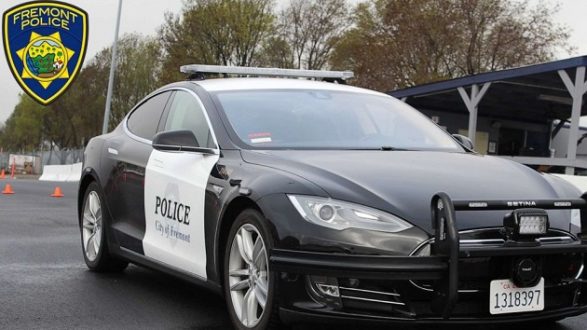
 Fremont Police Department(FREMONT, Calif.) — A California police department is adding fuel to the electric car debate after one of its patrol cars, a Tesla Model S, nearly ran out of juice during a vehicle pursuit last week.
Fremont Police Department(FREMONT, Calif.) — A California police department is adding fuel to the electric car debate after one of its patrol cars, a Tesla Model S, nearly ran out of juice during a vehicle pursuit last week.
It all started on a quiet Friday night in Fremont, when the city’s automated license plate reader system got a hit on a white Toyota Avalon entering the city’s limits and alerted the city’s authorities. The Toyota, wanted in connection with a felony in Santa Clara, was eventually located in an AutoZone parking lot by Fremont Police Officer Jesse Hartman at 11 p.m. on Sept. 20.
That night, Hartman was driving his department’s one and only Tesla patrol car, part of a six-month pilot program the Fremont Police Department was studying in an attempt to reduce emissions and improve efficiency. When the Toyota finally pulled out of the AutoZone parking lot, Hartman attempted to stop the vehicle.
“I lit him up and he is not yielding. We are in pursuit,” Hartman is heard saying over the radio, according to Broadcastify audio obtained by ABC News.
The pursuit then kicked off into a high-speed highway chase toward San Jose. Additional Fremont police officers and California Highway Patrol responded within minutes, as Hartman raced after the suspect at more than 100 miles per hour on Interstate-680 South. Meanwhile, requests for a CHP helicopter were made and San Jose authorities were notified.
“120 [miles per hour] … light traffic,” one officer said on the radio, police sirens heard ringing in the background.
Then the Tesla alerted Hartman that there was an issue with the vehicle.
“I’m down to six miles of battery,” began Hartman. “I may lose it here in a sec. If someone else is able, can they maneuver into the number one spot?” Hartman asked the other officers on the radio.
CHP took over the pursuit, as the male suspect started to drive erratically and passed over the center divide between the north and southbound lanes.
“At that point, we called it off for safety,” Fremont public affairs manager Geneva Bosques told ABC News. The pursuit lasted eight minutes.
“It’s very common to call off pursuits once they become safety issues,” Bosques added, citing the safety of other drivers on the road, despite the light traffic at the time.
As Hartman pulled off to recharge his vehicle, California Highway Patrol continued the hunt for the suspect, eventually locating the car a mile or two off the highway, abandoned. No other passengers were in the vehicle.
Bosques said the department still doesn’t know why the car wasn’t fully charged, but notes that Hartman’s shift started at 2 p.m. that day — nine hours before the pursuit began.
“Officers will usually travel 70-90 miles [in an 11-hour shift] so the car is regularly going two shifts without a charge,” said Bosques, adding that the general range of one battery charge is around 200 miles. The department’s general guideline is to start a shift with 50% of a gas tank or charge.
“But when you are driving and accelerating at high speeds, there are certain triggers that make the battery go faster,” she added.
Fremont’s population is around 235,000 people and has 199 sworn officers working for the area, according to Bosques.
While not the first police department to own a Tesla, it is the first agency in the United States to have a Tesla fully outfitted and working in a patrol capacity, said Bosques. The car was bought used in January 2018 and cost $61,000. It took more than a year for the department to outfit it with modifications like light bars, a push bumper, armored door panels and a prisoner cage.
Fremont is also home to a Tesla factory, something the department took advantage of when making its modifications.
“We were able to work with a couple of Tesla engineers to disable some of the equipment” like alert sensors that kept going off when we installed the pushbar to the front of the car, said Bosques.
The six-month pilot program, which officially ended Wednesday, will be used to track data and statistics in hopes the department can reduce its carbon footprint but also save the city money in the long term. The team will be looking at actual mileage-per-charge, vehicle downtime and maintenance costs, among other items.
According to the department, despite the Tesla costing $20,000 more than a Ford patrol car to purchase, the Tesla’s five-year maintenance and repair costs are expected to be $3,900, compared with a Ford vehicle’s costs of nearly $16,000.
ABC News reached out to the Santa Clara Police Department for an update on the apprehension of the Toyota Avalon’s driver but has not heard back yet as of Thursday.
This is the second pursuit the department’s Tesla has been involved in. In the first instance, the Tesla was chasing a vehicle involved in auto burglarly and that suspect was caught, according to Bosques.
“It’s meeting the expectations that we’ve had for it. It’s handling well,” said Bosques, adding that this could have happened with any car, gas or electric.
“We do run out of gas [on pursuits]. It happens. We’ve also had regular cars get flat tires on a pursuit, or cars that just die on a pursuit,” she continued.
“It’s definitely good to know [this can happen but] it did not jeopardize this pursuit,” she added.
Copyright © 2019, ABC Radio. All rights reserved.










